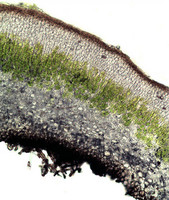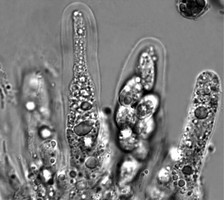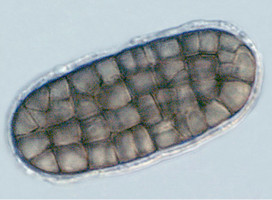Verrucariales
Cecile GueidanIntroduction
The order Verrucariales includes mainly taxa living with autotrophic organisms to form lichen symbioses. The majority of these photosynthetic partners belong to the green algae but brown, yellow and red algal partners are also known among photobionts of Verrucariales. The broad phylogenetic diversity of photobionts in the Verrucariales contrasts with the largest group of lichens, the Lecanoromycetes, probably because of the exceptionally broad habitat preference across this order, ranging from dry to aquatic conditions, and including freshwater and marine habitats. Generally, the two partners of these symbioses share a mutualistic relationship, but some of these fungi depart from this partnership with “reciprocal benefit” and act as parasites on other lichens. Some of them are still associated with a photobiont, but complement their nutrient uptake by invading and parasitizing lichen thalli (lichenicolous lichens). Others have lost their association with the photobiont, and live as commensals or parasites on other lichens (lichenicolous fungi). Therefore, although most of the Verrucariales are mutualists, lifestyles in this order are diverse, including also commensalism and parasitism.
Verrucariales are cosmopolitan, and include mostly saxicolous species, which colonize rocks ranging from small pebbles in rivers or glades, to boulders and cliffs, but also artificial substrates such as concrete or stone walls. They are particularly diverse on calcareous substrates, where they grow either epilithic (over the surface of the rock) or endolithic (within a superficial layer of the rock). Verrucariales are not as common on acidic rocks, except when they are in marine or freshwater aquatic habitats. Although a large majority of the Verrucariales is saxicolous, a significant number of taxa grow on different substrates, such as soil, bark or wood, mosses, or even other lichens.
Characteristics
Most of the Verrucariales are lichenized and, therefore, form a lichen thallus. A broad diversity in thallus morphology is represented in this order: foliose-umbilicate, squamulose, crustose and granulose. Consistently with a narrow range of thallus coloration, species of Verrucariales lack the secondary metabolite diversity so characteristic of the Lecanoromycetes, the class of ascomycetes including the largest diversity of lichenized species. However, some species of Verrucariales are rich in a dark pigment probably related to melanin. Similar to the Pyrenulales, vegetative propagules such as isidia or soredia are very rare in the Verrucariales, although the thallus structure can be quite complex. Asexual reproduction is still possible since squamulose and crustose-areolate thalli are prone to fragmentation. Sexual reproductive structures certainly play a major role in dispersal in this group.
The reproductive structures of the Verrucariales form perithecial ostiolate ascomata, ranging from superficial to entirely immersed in the thallus, sometimes entirely to partially covered by a carbonaceous shield called involucrellum (=clypeus). The hamathecium (a group of sterile elements located within the reproductive structures) is often restricted to the periphyses, bordering the ostiolar canal, and the short pseudoparaphyses covering the upper part of the perithecial cavity, below the ostiolar canal (Janex-Favre 1970). They lack, at least at maturity, interascal sterile hyphae, except for the Adelococcaceae, a small family of Verrucariales, in which interascal sterile hyphae are persistent (Matzer & Hafellner 1990, Treibel 1993). Asci are described as bitunicate (Eriksson 1982; Janex-Favre 1971), with a dehiscence occurring by gelification of the apical part of the outer wall (Grube 1999).
Discussion of Phylogenetic Relationships
Currently, almost all genera belonging to the order Verrucariales are included in the family Verrucariaceae (Eriksson 2006). Two other genera, also included in the Verrucariales and characterized by their long and persistent interascal elements (paraphysoides according to Triebel 1993) in addition to their short pseudoparaphyses, and by their lichenicolous habits, are classified in the second family of this order, the Adelococcaceae.
References
Janex-Favre, M.C. 1971. Recherches sur l’ontogénie, l’organisation et les asques de quelques pyrénolichens. Rev. Bryol. Lichénol. 37: 421-650.
Eriksson, O.E. 1982. The families of bitunicate Ascomycetes. Opera Botanica 60: 1-209.
Eriksson, O.E. 2006. Outline of Ascomycota, 2006. Myconet 12: 1-82.
Grube, M. 1999. Epifluorescence studies of the ascus in Verrucariales (lichenized Ascomycotina). Nova Hedwigia 68: 241-249.
Matzer, M. & Hafellner, J. 1990. Eine Revision der lichenicolen Arten der Sammelgattung Rosellinia (Ascomycetes). Biblioth. Lichenol. 37: 1-138.
Triebel, D. 1993. Notes on the genus Sagediopsis (Verrucariales, Adelococcaceae). Sendtnera 1: 273-280.
Title Illustrations

About This Page

Duke University, Durham, North Carolina, USA
Correspondence regarding this page should be directed to Cecile Gueidan at
Page copyright © 2008
All Rights Reserved.
- First online 29 January 2008
- Content changed 29 January 2008
Citing this page:
Gueidan, Cecile. 2008. Verrucariales. Version 29 January 2008 (under construction). http://tolweb.org/Verrucariales/29307/2008.01.29 in The Tree of Life Web Project, http://tolweb.org/












 Go to quick links
Go to quick search
Go to navigation for this section of the ToL site
Go to detailed links for the ToL site
Go to quick links
Go to quick search
Go to navigation for this section of the ToL site
Go to detailed links for the ToL site